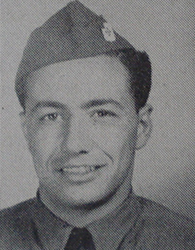In Belgium, a small village of 250 inhabitants organised a solemn mass during one of the most beautiful Sunday. This mass was organised by the villagers and the local priest to pay respect to an American soldier who gave his life for the liberation of Europe, but in particular for the liberation of that small Belgian village along the French border.
In the early morning of the 3rd September 1944, Private Dominick G. Gatto, a scout from the Intelligence & Reconnaissance Platoon of the 47th Infantry Regiment, veteran of North Africa Campaign, Tunisia, Sicily and Normandy, was driving a jeep with other members of his squad whilst in reconnaissance toward Leugnies (Belgium), when German antitank gun spotted them. Gatto, who lived in Bound Brook (NJ), was killed instantly, and his two comrades had to retreat for cover, leaving Gatto’s lifeless body in a ditch alongside the road. He was 28 years-old.

Private Dominick G. Gatto
Fort Bragg, 1941
47th Infantry Regiment Yearbook, 1941
Later that day, Chaplain Father Anthony DeLaura, 38 years old, former assistant of rector of the St. Joseph Church, decided to return to the scene to recover poor Gatto’s body. But when he arrived at the place indicated by the witnesses, he found no body. It was not until the following day that Father DeLaura realised that the body of the deceased liberator had been recovered and cared for by the locals.
The Chaplain was taken to a small, modest house in the village centre, where he discovered the body of the soldier lying peacefully on a bed surrounded by bouquets of freshly cut flowers. His helmet and raincoat lay by his feet, and a Belgian flag dating from the First World War hung on the bedroom wall. Two members of the Belgian Resistance watched over the body at all times.
Chaplain DeLaura met the Mayor and the local priest, who informed him that a young girl found the body. The Mayor told Father De Laura that a funeral service would be organized in dedication of Gatto later in the afternoon, and asked for the participation of the Chaplain.

Behind two altar boys carrying a cross, the funeral procession walked toward the church along the main road. Following the procession, Chaplain DeLaura, the priest and his assistants, 40 young girls carrying flowers, two members of the Belgian Resistance, the local music band and the carriers of the coffin, covered by an American flag. Local people also followed the procession.
From the regiment, in addition of the Chaplain and his assistant, John E. Mc Adams, from Greenbury, PA, Emilio Franciosa, from New York City and George E. Hutton, from Harrisburg, PA also attended this ceremony.

In this small Catholic Church, the Belgian choir ended the funeral service in singing the Star Spangled Banner. Father DeLaura, assited by two Belgian priests, directed a solemn requiem, a great mass, the most important ceremony planned for a catholic church. The choir then interpreted Belgian national anthem at the end of the ceremony.

Leugnies Church
The funeral was originally scheduled to take place after mass that afternoon. But the authorities had to change their plans when they learned that the Germans had destroyed or stolen the gravedigger’s equipment. The body had to be returned to the morgue. Buglers ran again, and the little girls with their flowers walked silently in front of the coffin. A Belgian honor guard was present, and Private Dominick G. Gatto was buried in the first American Cemetery in Belgium, in Fosse-la-Ville, on the same day, the 4th September 1944.

Dominick Gatto’s grave at Fosse-la-Ville U.S. Cemetery, Belgium
Dominick Gatto’s grave in Saint-Joseph Cemetery
Bridgewater Township, NJ

Every year on 3 September, the inhabitants of the surrounding villages still gather to remember the ultimate sacrifice made by soldier Dominick G. Gatto during the liberation of Belgium. A monument has been erected on the spot where the soldier’s body was found, and the young people of the village of Leugnies continue to care for this place of remembrance, while sharing this story so that future generations never forget that peace and freedom come at a cost: the lives of young men and women.


Comments are closed